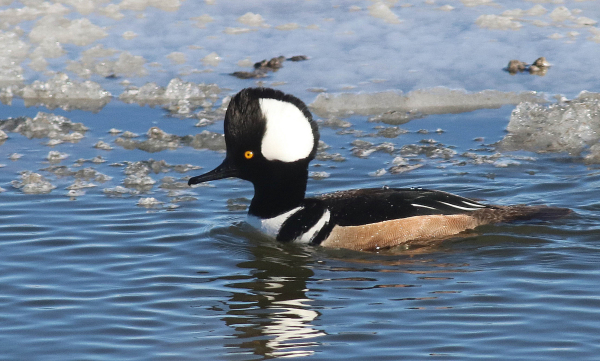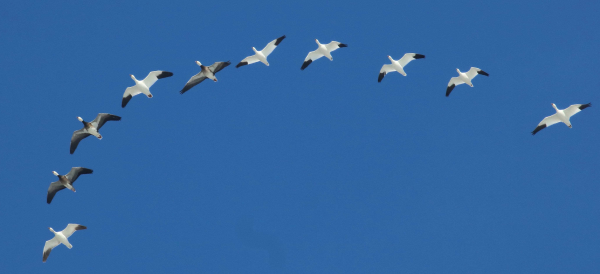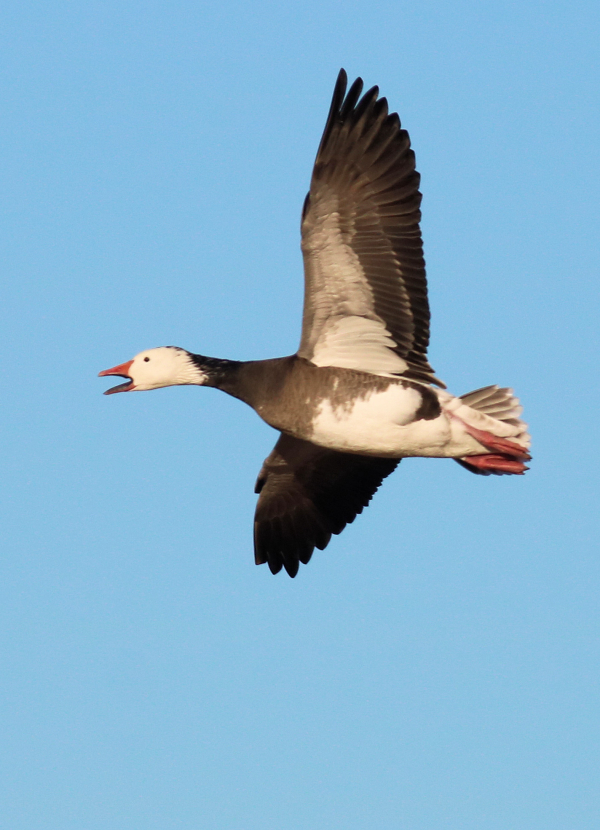
As ice formed on area lakes, small flocks and single Hooded Mergansers migrated into the area, along with a few Common Goldeneyes and flocks of Buffleheads.

Snow and Ross’s Geese dictated the Dakota sky and landscape this week.

An adult mostly blue morph Snow Goose shows a telltale white belly that indicates a hybrid blue morph and white morph ancestry.
|
Freeze-up was pretty serious by Thursday, with only the deepest lakes providing open water for the new vanguard of Snow and Ross’s Geese in the area. The biggest flocks were present Saturday, and there were probably more than 20,000 in the area, with the largest flock numbering about half that total. One flock was feeding less than a mile from my house, and multiple flocks flew low overhead as I worked outdoors a while. As the sun was setting I enjoyed a front row seat near the largest flock and took some time to absorb the essence of the scene.
While the flocks superficially look like they are just Snow Geese, when I began to study the composition of the geese, I was surprised by the number of Cackling Geese mixed in. How could they stay so incognito from a distance? But the answer is that the Snow Geese are a salt and pepper mix of white and blue morph geese. Without binoculars, it’s almost impossible to pick out Cacklers from “blue” Snows. White-fronted Geese are even tougher to pick out, but with binoculars it was fun to find the rarer White-fronts in the expansive flock. Then there are the little Ross’s Geese, which are noticeably smaller than the white morph Snows, although from a distance they look like almost identical miniature copies. Their shorter, smaller stature, smaller bill, and smaller head make them a little more obvious among the Snows.
Even within this mega-flock of four species of Arctic-nesting geese, each species offered some interesting variations, such as the differences between adult White-fronts and their young of the year. Likewise for white and blue Snows and Ross’s Geese, and it was fun to watch family interactions within the giant flock. For me, the most interesting group are the blue morph Snows that form about 40 percent of the Central Flyway populations. Among the blues, you see a broad variety of coloration. There are the “pure” adult blue geese with a white head and neck, and there are gray-blue first-fall blues that lack any white plumage, but you will also see examples of hybrid adult plumages that indicates an ancestry of white and blue morphs.
The hybrid morphs mostly resemble a blue adult, but they show a varied amount of extra white plumage – most often a white belly. But some have more extensive white coloration that extends from a white belly to their breast, and sometimes into the neck. Some have even more extensive white extending from their belly up their sides so they resemble a white morph more than a blue. It’s fun to study some of these mixed-morph Snow Geese, and it’s a thrill to photograph examples of the variations.
In the enormous flock that extended almost a half mile south to north, the geese were constantly moving, with potions of the huge flock hop-scotching northward from the south end, along with flock after flock literally falling from the sky to join the social feast. Watching the geese cupping their wings to lose altitude quickly made me imagine the thrill of flight, but I get the biggest thrill when geese begin whiffling downward – dropping one cupped wing very low, followed by dropping the opposite wing low, quickly repeating the process to quickly teeter-totter steeply downward, almost dropping straight down in the process.
Even though geese are much more abundant now, most hawks have left the area; but a scattering of Bald Eagles have moved in as they shadow the big flocks of geese. Sunday morning I enjoyed a surprise photo experience when I spied an eagle ahead. To get into position with respect to the direction of the sunlight, I would need to pass by the big raptor. I knew that was unlikely, but I continued forward, ready to stop if the eagle took flight.
There was no way to avoid disturbing the eagle – the next car to pass would flush it. When the adult Bald Eagle flew to the northeast with its tail pointed in my direction, I figured the episode was over, but to my surprise the majestic adult banked and flew low directly toward me with the benefit of good lighting. I took a series of photos as it approached until it was too close for my lens to focus on it – fun! Then the eagle surprised me again as it began circling, mostly directly above me. The poor light didn’t permit good photo ops, but I sure enjoyed having the grand eagle climbing the air waves in tight circles overhead – Whoo!
Throughout the week I’ve enjoyed seeing one or two flocks of Tundra Swans passing by daily, some flocks numbering 6, 11, 12, and 15; another was composed of a family group with two adults and three young swans. I also observed another flock of 28 migrating Sandhill Cranes early in the week, and an unusual lone Sandhill flying south Saturday afternoon. A real indicator of the advent of the freeze-up season was the appearance of Common Goldeneyes and Hooded Mergansers, along with many more Buffleheads. Common Mergansers are usually the last to follow, and they can’t be far behind.
At my feeders, in addition to the usual crew, Friday I had a winter-plumage American Goldfinch stop for a few nyjer seeds, followed by the first House Finch I’ve seen in more than a month, but neither returned after a quick visit, despite my attractive buffet. Then Monday afternoon I had a fleeting glimpse of a tiny new species for the area; next to my feeding station a Golden-crowned Kinglet appeared! Wish it would have given me a good look and a better chance to study it a bit, but even with just two quick glimpses of it I could identify the kinglet by its diminutive size and its black and white striped crown in the poor light.
Monday the sky was filled with geese, all day long, in every direction. All five species were involved, but 95 percent must have been Snow Geese. At one time outside my front door, I counted five different distinct flocks of geese at different levels of altitude, some flying in different directions, with the largest of these flocks composed of six long Vs of geese.
I observed five different feeding concentrations numbering more than 1,000 to the south, although most of them were far larger than that and a couple flocks undoubtedly numbered more than 10,000. One flock permitted me to spend a quarter hour observing and photographing them within a couple hundred feet of the geese at the edge of the Snow mass. It was nice to have them so close and so relaxed; feeding, preening, and even laying down in the wheat stubble, and they offered great looks at the plumage variations again, although the species composition was purely Snows and small percentage of Ross’s Geese.
Oh yeah, I also sighted another Northern Shrike. Looks like a cold week ahead, but that always brings added excitement to Dakota country.
Article and photos by Paul Konrad
Share your bird sightings and photos at editorstbw2@gmail.com